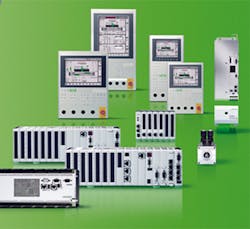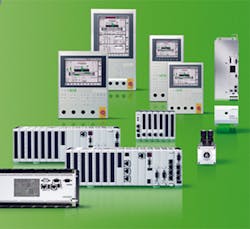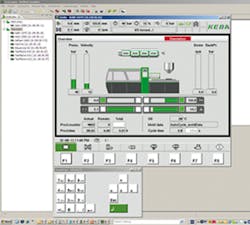Special Report: Demand for remote monitoring systems growing
April 19, 2016
10 min read
Injection molding machinery suppliers that offer software for process and production monitoring say demand for remote monitoring continues to drive adoption of their systems. Four machinery suppliers provided an update on their technologies.
NIIGATA ENHANCES
DATA COLLECTION
"For many customers, it is cumbersome to monitor and gather data from each machine, especially if the presses are operating in a clean room where it is not advisable to continually enter that space, or when machines are scattered at different locations,'' said Peter Gardner, VP sales and GM for DJA Global Group, Niigata Operations – North America, Wood Dale, Ill. "They are now asking for capabilities that allow them to pull all required data from the machine to a cloud server or other remote location, and they even want to be able to put data back to a machine, in the form of loading a recipe … or signaling for an adjustment to a machine parameter."
In January, Niigata introduced its V9 machine controller, now installed as standard equipment on all injection molding machines in its product line. The controller incorporates new and enhanced monitoring capabilities that make remote monitoring easier, as well as upgraded preventive maintenance functions.
The V9 controller processes data faster than the previous V8 version, so users see operating values, temperature and pressure indicators and graphs more quickly. The V9 controller features a remote data system program that connects it to the Internet. Using open-source software, users can access all data remotely via a tablet, smartphone or PC. Previously, remote monitoring was carried out using a proprietary program. The switch to open-source software allows the user to connect to a wider range of mobile and remote devices more simply.
"Molders are monitoring every aspect of their molding process, every temperature, every motion and every change. Molders are monitoring the temperature inside of a control cabinet, or the amount of travel undertaken by a ball screw, or they monitor the torque duties of a servo motor or tie-bar stretch," Gardner said.
Molders are looking to monitor any aspect of their processes that they believe can push the machine or part out of spec. "They even monitor the air conditioning in the plant," Gardner said. Storing that process and production data remotely on a server at the plant or on a cloud-based server gives a molder the ability to view process and production data quickly.
Niigata has updated the production manager functions embedded in the V9 controller as they pertain to remote connectivity. Through the production scheduler, users can change the number of cycles or parts produced, and can back the screw off, turn the heat down and purge material. Auxiliary equipment also can be connected to the V9 controller for monitoring, says Gardner.
Niigata also developed what it calls a molding assist/expert program that lets a molder transfer a mold setup created on one Niigata press to another Niigata press of a different size or capability. This saves the molder from having to start the mold setup from scratch.
Data about the part (such as resin, mass, sprue information, part thickness) is entered into the program, as is data related to the capabilities of the press where the mold will be moved is entered into the program. The molding assist/expert program automatically converts all process values, which then can be saved to a USB drive or uploaded to a server. "Injection start position, finish position, pressures and other relevant values are converted. When the data is installed in the new machine, molders use a Condition Calculation Expert function to adjust the process/production conditions of the machine running the mold," Gardner said.
ABSOLUTE HAITIAN CONCENTRATES
DATA OFF THE PLANT FLOOR
Absolute Haitian Corp., Worcester, Mass., now incorporates the improved functionality of the KePlast EasyNet 2.0 process monitoring system from Keba AG of Linz, Austria, into its machine lines that use Keba controls, said Aaron Galindo, controls product specialist for the injection molding machine manufacturer.
KePlast EasyNet 2.0 is the latest generation of monitoring capability and replaces EasyNet 1.0. It is ideally suited to centralized management of machine data and production data files, and provides networking and remote and mobile access to machine process data, Galindo said. Keba is represented in the U.S. by Keba Corp., Valparaiso, Ind.
EasyNet 2.0 runs on Keba's newer 2580 and 2880 control platforms and incorporates a faster communications protocol that is compatible with Windows 10, 8 and 7 operating systems, Galindo said. This is in contrast to KePlast EasyNet 1.0, which runs on a Keba 4030 control platform and is supported by Windows XP.
A remote monitoring software package is a standard option to the EasyNet 2.0 system and meets demand for ease of use and capability. "The updated system operates at a higher speed than the previous system. Users can view a range of production data and can monitor the mechanics of the machine itself from a remote location. If interested in the barrel temperature profile on an injection unit, a user can view the content of the monitored data through a laptop or smartphone. Gaining access to process and production data remotely continues to be a strong trend in the industry," Galindo said. EasyNet 2.0 has security encryption built in to provide data integrity and privacy over a computer network.
EasyNet 2.0 sits on a host PC and connects to any injection machine that has a Keba controller. The user interface for EasyNet 2.0 is identical to that employed for the machine control, so no additional training is required. Absolute Haitian equips its Iapetus II, Jupiter II, Mars II, Saturn II and Mercury II injection units with Keba controls; its Venus II and Zeres series machines use Sigmatek controls.
Enhanced capabilities include the ability to monitor up to 38 parameters relating to process, production or machine status. Users can select the data points they want to view and can hide others. Mold data and machine information can now be saved to the remote PC running EasyNet 2.0. "The risk of losing that information at the machine is minimized because a backup is created and stored in a remote location," Galindo said.
The software allows for tracking of process parameters shot by shot using a graphical monitoring feature. Molders can compare the productivity of the machines linked through the network.
TOSHIBA DEVELOPS OFF-LINE
MONITORING CAPABILITY
Toshiba Machine Co. America, Elk Grove Village, Ill., has developed two approaches to process and production monitoring that complement its remote real-time plant-monitoring system. The original system, iPaqet, is able to monitor up to 48 Toshiba machines equipped with the company's Injectvisor machine controller, introduced in 2008.
The new iPaqet Lite system is designed to monitor up to 30 user-selectable process variables drawn from a single injection press. Mold setup information, screen dumps and the monitored process data from every shot can be downloaded to a USB stick, allowing the data to be viewed and analyzed off-line using conventional analysis software, said Michael Werner, senior technical key account manager, plastics machinery division.
"One of the newer processing variables that can be monitored and captured with iPaqet Lite is the measure of transfer pressures at different injection speeds. Users can determine the impact on part quality due to transfer pressure at each transition of injection speed," Werner said.
The iPaqet Lite system is a standard feature in Toshiba's most recent machine controller, the Injectvisor V50. This control system replaces Toshiba's V30, and is designed with a 15-inch touch screen using what Toshiba calls a high- performance HMI that displays all necessary process information on a split screen. Process and production data shown on the split screen is independent of the setup screens.
Features of Injectvisor V50 include a 40 percent increase in communication speed between controller and machine. The new controller uses real-time process and production inputs to report mold conditions. It is designed to automatically adjust mold settings.
Toshiba also offers its Moldlyzer software, which monitors melt pressure during injection. It is designed to automatically establish upper and lower tolerances or bands as a means of ensuring the process is within parameters. "We have had Moldlyzer for a few years, but it is a monitoring function that we are raising the awareness of," Werner said.
Moldlyzer is activated by the molder once the process is in a steady state, at which point the processor presses a button and the system displays the highest and lowest pressure curves recorded over a period of time. The molder can adjust the tolerance limits with a simple plus or minus adjustment to the pressure curve, or they can place a limit on the area under the pressure curve. "During injection, the area under the pressure curve reading on the screen should be similar from shot to shot, as this signifies that the tool is seeing the same output of material or the same displacement into the tool," said Werner.
HUSKY UPDATES SHOTSCOPE NX
Husky Injection Molding Systems Ltd., Bolton, Ontario, announced enhancements and new software modules for its Shotscope NX web-based, real-time process and production monitoring system.
Husky added new features that make it possible for the system to automate the collection of all data required to calculate overall equipment effectiveness. "Machine alarms and stop reasons can be linked to downtime reasons, such as preventive maintenance or auxiliary issues. Users no longer have to manually enter downtime, which has been automated with this step," said Peter Blenkiron, Shotscope NX product manager. The system records machine shutoffs and generates reports about why they occurred. It also automatically collects cavitation information from the injection press, then calculates how well the machine is producing parts, based on any number of parameters, Blenkiron said.
As part of its improvements of Shotscope NX, Husky enhanced an energy module it developed and commercialized last year that measures power on any type of equipment and relates it to energy consumption. "Based on customer feedback, we added functionality where customers can select the data sampling rate of the data displayed," Blenkiron said. An example is a dryer on a 4-hour desiccant bed cycle. The dryer uses more energy to dry the bed at the beginning of the cycle, so data that was collected every 15 minutes would show big fluctuations, but wouldn't be useful in gauging the machine's overall performance. Instead, users need the ability to view data over longer time spans, such as one sample per day, to eliminate cyclic variations that occur, Blenkiron said.
Husky also added a new report module that emails reports to a predetermined list of recipients at a specific time. Customers no longer need to invest extra time to request data from Shotscope NX, according to Blenkiron.
In addition, Husky improved the interface between its injection presses and the Shotscope NX unit. Upgrades include a tool-cavitation detection signal that will now be sent from the molding machine into Shotscope NX; and a machine set point support feature in which changes to machine set point are stored on the server and displayed on statistical process control charts. A new Mold ID support allows information about molds that have identification tags to be stored on Shotscope NX, said Blenkiron. "Storing the information eliminates the need for customers with Shotscope NX to use other manual methods to transfer mold tag data between machines," he said.
Mikell Knights, senior correspondent
Contact:
Absolute Haitian Corp., 508-459-5372, www.absolutehaitian.com
Husky Injection Molding Systems Ltd., 905-951-5000, www.husky.co
Niigata Machine Techno Co. Ltd., 630-875-0202, www.niigata-us.com
Toshiba Machine Co. America, 847-709-7000, www.toshiba-machine.com
About the Author
Sign up for our eNewsletters
Get the latest news and updates



